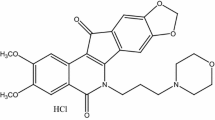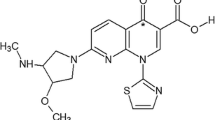Abstract
Purpose: 10-Hydroxycamptothecin (HCPT) is an indole alkaloid isolated from a Chinese tree, Camptotheca acuminata, and has a wide spectrum of anticancer activity in vitro and in vivo mainly through inhibitory effects on topoisomerase I. HCPT has been shown to be more potent and less toxic than camptothecin and has recently undergone clinical trials. To determine how HCPT might be best used as an anticancer agent, preclinical studies of the pharmacokinetics, tissue distribution, metabolism and elimination of HCPT in rats were undertaken. Methods: HCPT was administered to rats by i.v. bolus injection at doses of 1, 3, and 10 mg/kg body weight. HCPT (lactone and carboxylate) and its metabolites in plasma, urine, feces, and various tissues were quantitated by reversed-phase HPLC. Pharmacokinetic parameters were then estimated. Results: Following i.v. administration at doses of 3 or 10 mg/kg, the plasma concentration-time profile for lactone HCPT could be best described by a three-compartment model, with terminal elimination half-lives of 140.4 and 428.6 min, respectively. A two-compartment model was used to fit the plasma concentration-time curve at 1 mg/kg, with a terminal elimination half-life of 30.5 min. Carboxylate HCPT had a longer half-life than the lactone form of HCPT. During the initial 6 h after dosing, urinary excretion was the major route of elimination, and fecal excretion became the major route of elimination thereafter. HCPT was widely distributed to various tissues including the enterohepatic system, kidney, and bone marrow. The lactone form of HCPT was detectable in various tissues examined up to 72 h after dosing at all the three test doses. HCPT glucuronides were present in plasma, urine, feces and various tissues. No significant toxicity was observed at doses of 1 or 3 mg/kg. Polyuria and hematuria were observed only during the initial 3 h after dosing at 10 mg/kg. Conclusions: Prolonged elimination of HCPT in vivo may have a significant impact on its therapeutic effects. HCPT is metabolized to its carboxylate form and glucuronides. Dose-dependent toxicity was observed with i.v. administration of HCPT. The results of this study should be useful in the design of future human trials with this anticancer drug.
Similar content being viewed by others
Author information
Authors and Affiliations
Additional information
Received: 6 September 1996 / Accepted: 15 July 1997
Rights and permissions
About this article
Cite this article
Zhang, R., Li, Y., Cai, Q. et al. Preclinical pharmacology of the natural product anticancer agent 10-hydroxycamptothecin, an inhibitor of topoisomerase I. Cancer Chemother Pharmacol 41, 257–267 (1998). https://doi.org/10.1007/s002800050738
Issue Date:
DOI: https://doi.org/10.1007/s002800050738




